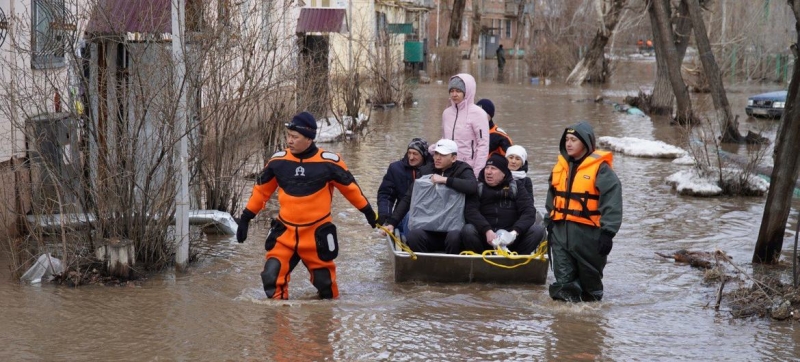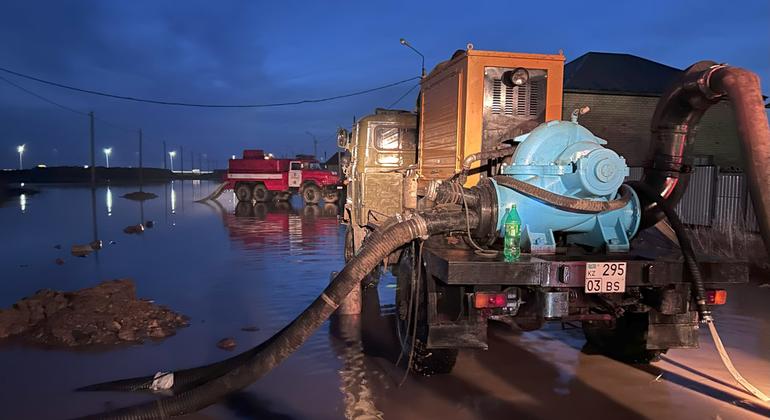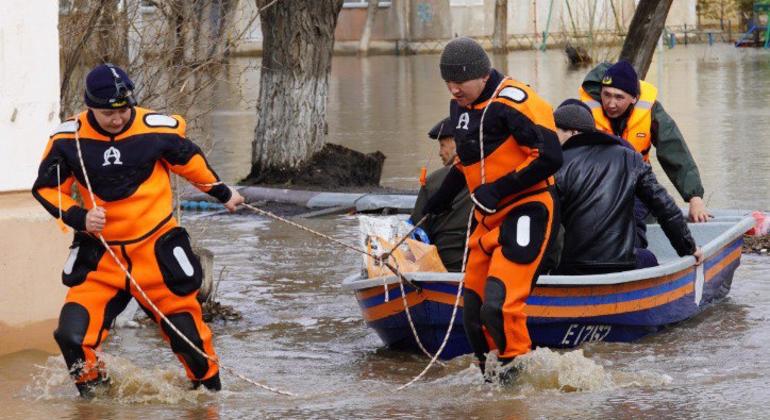
“Big water” came to 10 of 17 regions of Kazakhstan, as a result of which almost 18 thousand residential buildings in cities and villages of the country were flooded. “Big water”: Kazakhstan learns to minimize the consequences of disasters caused by natural disasters Kulpash Konyrova Climate and environment
In Kazakhstan this year, spring floods, which lasted for two whole months, became the largest natural disaster in the last 80 years. Almost half of the territory of the largest country in Central Asia was under water, dozens of cities, hundreds of villages were in the disaster zone. The report from this republic is timed to coincide with the World Day for Disaster Risk Reduction, which is celebrated on October 13.
Emergency State
With the onset of spring, “big water” came to 10 of 17 regions of Kazakhstan, as a result of which almost 18 thousand residential buildings in cities and villages of the country were flooded. The western and northern regions of the republic were the first to face the water disaster. 120 thousand people found themselves in the disaster zone and needed urgent evacuation. A state of emergency was declared in the country.
Thanks to modern gadgets, people from the localities posted photos and videos about the situation on social networks. The scale of the disaster could be seen practically in real time. It was painful to see on video the tears and suffering of residents whose houses were covered with water up to the roof, as in a matter of hours and minutes, right before their eyes, the elements mercilessly destroyed years of their labor.
“The hardest part of our work during the evacuation was seeing how people were more afraid for their property than for their lives. Many did not want to leave their homes until the very end. There was an incident that shook me personally,” Yerik Sarybayev, a representative of the Ministry of Emergency Situations of Kazakhstan, told the UN News Service. “An 80-year-old grandmother from a village that was completely under water came up to me. She asked me for help, to take her home, if possible, by boat, to pick up something very important to her. I showed her a video from a drone that showed her house being flooded up to the roof, and then she cried bitterly because she forgot to take her family photo album with her, which contained all her memories of her life and her family. All of this was irretrievably destroyed by the water.”

Causes of abnormal floods
“Nature has no bad weather, every weather is a blessing,” goes a hit song from a popular Soviet film of its time. Kazakhstanis who have lived through the current flood will most likely disagree with these words. In recent years, nature has been increasingly presenting surprises that are becoming increasingly difficult for humanity to cope with, despite the scientific and technical progress achieved.
Erik Sarybayev believes that the abnormal flooding in Kazakhstan is primarily due to climate change. “Several natural factors contributed to such a powerful flood. Autumn arrived in the republic later than expected. Then the rains turned to snow, and the warm weather turned to a sharp cold snap. All this led to the formation of an ice crust between the soil and the snow cover, which prevented the earth from getting rid of excess moisture in the spring. The situation repeated itself in the spring: frequent alternations of heat and sudden cold worsened the situation, which led to high water, when rivers and lakes overflowed their banks, sweeping away everything in their path,” explained the representative of the Ministry of Emergency Situations of Kazakhstan.
“Asar” in Kazakh means “with the whole world”
The Kazakhs have an ancient custom called “Asar”. This is when people gathered together and helped a person or family in trouble for free. The origin of the custom is dictated by the damp conditions for survival in the steppe.
From the very beginning of the emergency, the President of Kazakhstan Kassym-Jomart Tokayev made an urgent appeal to the population of the country. Addressing citizens, he promised all possible assistance to those affected by the flood.
“The fight against the elements required the mobilization of large human and financial resources. Military units of the Ministry of Defense, Internal Affairs, and the National Guard came to the aid of the Ministry of Emergency Situations,” said Sarybayev.
In addition, residents of the regions that were bypassed by the elements responded and went as volunteers to the places where they built dams together with local residents to protect cities and villages. Both “young and old” came out to fight the elements. In some villages, one could see how aksakals (white-bearded, that is, elderly people – author’s note) helped soldiers, together with small children, fill bags with earth and sand to strengthen the dams.
Seeing the scale of the destruction caused by the elements, the country’s authorities decided to cancel the planned large-scale image events. The country’s president announced the unblocking of the state material reserve, which has never happened before.
According to the government, more than 34 thousand Kazakh families received a one-time cash assistance in the amount of 369,200 tenge (800 dollars) for a total of 12.6 billion tenge. Material damage was compensated: the victims were paid 553,800 tenge (approximately 1,200 dollars) so that they could buy essential household items. 21,800 families received such payments.
Not only volunteers and local construction companies took part in the restoration and construction of residential buildings destroyed by the elements, but also Kazakhstani businessmen from the Forbes top 50 list made their contribution. In just four warm months, 2,642 houses based on standard designs were built in the regions affected by the flood using budget and sponsor money, almost six houses and apartments were bought on the secondary market, and more than nine houses were repaired.

Working on Bugs
In addition to the surprises of nature, another reason for the great damage from the natural disaster in Kazakhstan was the weak forecast and analytical work of Kazhydromet. Thus, it turned out that in the Aktobe region (northwest Kazakhstan) up the Zhem (Emba) River, which originates in the Mugaldzhar Mountains, there are almost no hydroposts, as a result of which about 2,700 houses in the village of Kulsary were under water.
Sufficient technical equipment would have helped to minimize the damage from emergencies. All this was taken into account.
“Conclusions are being made, but pay attention to the fact that similar natural disasters have swept virtually the entire globe. Just recently, large floods occurred in Central Europe, before that a hurricane passed through the USA, there was a very large hurricane in Vietnam. “Such natural disasters are difficult to predict, but it is absolutely necessary to be prepared for them and take preventive measures,” the President of Kazakhstan said recently, answering journalists’ questions about whether conclusions had been drawn after the flood.
He stressed that Kazakhstan was able to cope with the natural disaster without outside help, having managed to mobilize its financial and human resources.
Currently, the Ministry of Emergency Situations and the Ministry of Digital Development are working together, drawing on the experience of Germany and the Netherlands, to create an information system that will allow modeling all possible emergency situations, making appropriate forecasts, recommendations and action steps. It should be completed by the end of the year. And in February next year, the government plans to receive the first forecasts for future floods.
Early warning systems
In 2022, United Nations Secretary-General António Guterres called for a global effort to ensure that every person on Earth is protected by early warning systems by 2027.
With human-induced climate change leading to more extreme weather events, the need for early warning systems is more urgent than ever. Systems that alert people to impending storms, floods, or droughts are not a luxury, but a cost-effective tool that can save lives, reduce economic losses, and provide a return on investment of up to ten times.
Early warning systems help reduce the number of deaths, losses, and damages caused by hazardous weather, water, and climate events.
